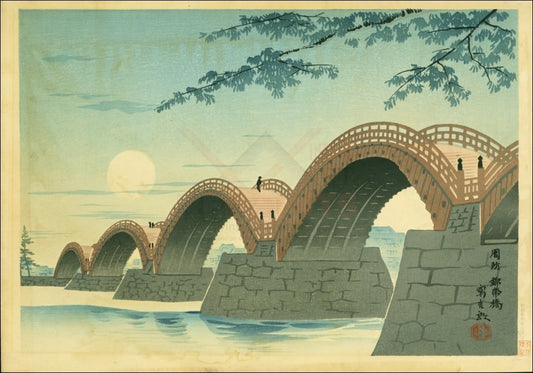Collection: Japanese Woodblock Prints I by T. Tokuriki
Woodblock printing in Japan is a technique best known for its use in the ukiyo-e artistic genre of single sheets, but it was also used for printing books in the same period. Widely adopted in Japan during the Edo period (1603–1868) and similar to woodcut in Western printmaking in some regards, the mokuhanga technique differs in that it uses water-based inks—as opposed to western woodcut, which typically uses oil-based inks. The Japanese water-based inks provide a wide range of vivid colors, glazes, and transparency.In 764 the Empress Kōken commissioned one million small wooden pagodas, each containing a small woodblock scroll printed with a Buddhist text (Hyakumantō Darani). These were distributed to temples around the country as thanks for the suppression of the Emi Rebellion of 764. These are the earliest examples of woodblock printing known, or documented, from Japan.
-
53 Stations on the Tokaido Way, Ando Hiroshige
Regular price From $39.00 USDRegular priceUnit price / per -
Ise Futami Bay, Woodblocks Prints I by T. Tokuriki
Regular price From $39.00 USDRegular priceUnit price / per -
Japanese Woodblocks Katata Ukimido Temple
Regular price From $39.00 USDRegular priceUnit price / per -
Kamakura Large Buddha I Japanese Woodblocks
Regular price From $39.00 USDRegular priceUnit price / per -
Mt. Shigi in Nara I Japanese Woodblocks Prints
Regular price From $39.00 USDRegular priceUnit price / per -
Nicho-Toshogu in Tochigi I Japanese Woodblocks prints
Regular price From $39.00 USDRegular priceUnit price / per -
Nicko-Toshougu in Tochigi Prefecture
Regular price From $39.00 USDRegular priceUnit price / per -
Suwa Kintai Bridge at Iwakini - Japanese Woodblocks I by T. TOKURIKI
Regular price From $39.00 USDRegular priceUnit price / per -
Temple Kiyomizu in Kyoto
Regular price From $39.00 USDRegular priceUnit price / per









